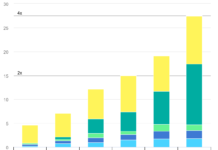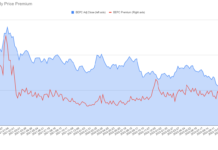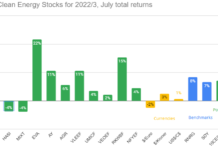Last week, we alerted you to a report from Germany’s Energy Watch Group called “Coal: Resources and Future Production,��? which predicts peak coal by 2025. Readers of AltEnergyStocks are doubtless familiar with peak oil, the inevitable fact that as we consume a finite resource (oil reserves) at some point the rate of that consumption must peak, and taper off. Serious arguments about peak oil center around "when" oil production (and consumption) will peak, not "if."
The same it true for other finite natural resources, such as natural gas, uranium, and even coal. The difference with coal is the received wisdom: that the US has two centuries of remaining coal reserves, with the (often unspoken) implication that there is no need to worry about it in our lifetimes. Other reports have drawn attention to peaking coal supplies before this, and I have no doubt that more will follow.
How to beat the market
As an advisor seeking superior returns for my clients, I take reports like this seriously. Dismissing them out of hand because it disagrees with the consensus view is not only close-minded, but a massive missed opportunity. That’s because, in order to achieve superior returns, I must accomplish four things:
- Have hypotheses that differ from the consensus view.
- Act (i.e. make investment decisions based) on those hypotheses.
- Be correct as often as not.
- Have a mechanism for testing the hypotheses, to enable a change of tactic when a hypothesis is proven wrong.
The first two are easy… but without numbers 3 and 4, I’d be just another whack-job in the blogosphere losing my own and my client’s money. Here’s how my hypothesis looks for peak coal:
1. A hypothesis. The consensus is too complacent about the supply of coal. Note that I don’t need to pin down a precise date for the peak in coal production (worldwide or in the US), I simply have to identify something I believe the majority of investors have gotten wrong and the direction of the error. My hypotheses are normally of this form: how the consensus view is incorrect.
2. See "How to prepare your portfolio for Peak Coal" below.
3. You don’t have to be right all the time. One of the great benefits of diversification is that it allows an investor to make mistakes. None of us is right all the time. For example, I’ve been bearish on the market as a whole since 1998… which means I was wrong in 1998 and 1999, right in 2000, 2001, and 2002, and wrong since then. However, despite the fact that I was wrong about the market for six out of the last nine years, over that time period, I put a large chunk of the money which I otherwise might have allocated to US stocks into foreign currency denominated bonds mostly through close-end funds such as the Aberdeen Global Income Fund (AMEX: FCO), because I expected a general decline in the dollar. Note that is is a vast oversimplification of one choice taken within my managed portfolios over the period, and should be considered educational, not taken as an example of past returns. Looking at this chart comparing SPY and FCO (I’m using SPY as a simple proxy for the US stock market as a whole) for the last nine years, you will note that SPY outperformed FCO over the period by about 25%. However, over that time SPY has had an average yield of around 1.5%, while the yield on FCO has averaged around 7%, over 9 years, that difference amounts to a 35-50% advantage for FCO (depending on the investor’s tax rate), for an advantage in total returns for FCO of between 10% and 25%, or 1 to 2% compounded annually.
Also note that risk (measured in terms of volatility) for FCO has been much lower than that of the market over that time period. So while I was wrong about the market 2/3 of the time over that period, I was correct about the general decline in the dollar a bit more than half of the time, and the extra income I earned with my risk adverse strategy of investing in bonds rather than stocks left me with a slight advantage over the period. Through these slight advantages, amounting to only 1-2% per year, a successful investor can dramatically increase his returns over the long term. Once again, these returns are only an example, showing the long term advantage of acting on the hypothesis that both the US market and the dollar would under perform over the last 9 years. I still believe both these to be true, and as a result, I and my clients continue to be over-allocated to foreign bonds, and under-allocated to US Stocks (with the exception of alternative energy.) Nevertheless, past returns are no guarantee of future results, which is why it’s important to…
4. Quickly recongnize when you’re wrong. Thinking again about my hypothesis the market is overly complacent about coal supplies, how can I know when it is incorrect, either because I was wrong to begin with, or because conditions have changed? That could happen because coal will continue to be as easy to mine as most investors think, or because they become as worried about coal supplies as the situation warrants. China, where the most rapid coal depletion is taking place, may indeed recognize the severity of coming shortages, but my hypothesis is primarily about investor in US markets. Until recently, the Chinese have mostly confined themselves to buying huge chucks of our Treasury and other agency debt, but we see them rushing to secure long term coal contracts in Africa and elsewhere. Since China is a net coal importer, it is much harder for them to be as complacent about coal reserves as we are in the US. At the moment, I don’t see any worrying at all about coal reserves in the popular press, and reporters typically accept the "200 years of coal" line without question. When that changes, it will be time to re-evaluate. As to my simply being wrong in my pessimism, even the normally Pollyanna-ish EIA estimates, coal production in the US will peak in 2060, which implies a peak in world production much sooner, because the US has the lion’s share of remaining reserves. I don’t believe that a world peak in coal production even as late as 2050 has yet been acknowledged. When it is, it will again be time to reevaluate this hypothesis.
What to expect from Peak Coal.
While I usually only make investments that I expect to pay off in 5-10 years time, and even the earliest predicted peak for world coal production is still 18 years off, the precise date of the peak is not at all
important for the purposes of investing. What is important is when we will see unexpected price rises as demand adjusts to constrained supply. As an example, the first effects of peak oil are not happening today; instead they happened in the early 70’s, when United States production peaked, and Texas could no longer act as the swing producer of oil, leading to a shift of production in the Middle East. Because of the new investment required, that shift took a number of years, during which time oil stayed at historically high levels, until new production caught up with demand.
Could something similar happen with coal? If any country is likely to be a driving force for world demand, sending prices up for everyone, that country is likely to be China, which is by far the largest producer of coal, but has only half the reserves of the US (according to the EWG report.) How many times have we heard that the US is the "Saudi Arabia of Coal"? If it is, the China is the "United States of Coal." I think a price spike in coal available for worldwide trade is the most likely investable event for peak coal in the near future.
Here are some effects I would expect from such a price spike.
- Coal prices in current coal importers would skyrocket.
- Coal prices in areas with easy access to ports would also rise dramatically.
- Transportation links such as rail from coal producing regions to ports, ports, and bulk shipping would also benefit.
- The price of electricity in regions relying on coal fired power (other than mine-mouth plants) would increase several cents per kWh.
How to prepare your portfolio for Peak Coal.
- Companies owning or discovering new coal reserves in coal importing regions will benefit dramatically. (I’m far from an expert on coal companies, so I have no specific recommendations here. I also avoid investment in coal because of the effects of mountaintop removal and global warming.)
- Coal mining companies with easy access to ports will also benefit dramatically.
- Rail lines with connections to large port facilities would benefit, as well as the port operators. (Again, I’m no expert.)
- Construction companies able to quickly build rail lines and expand port facilities will also benefit. (I don’t know much, do I?)
- Shipping companies who own large ore/coal carriers will benefit. Shipyards which produce these ships likewise.
- Companies that use coal for purposes other than electricity generation will be hurt. Avoid coal-to-liquids companies such as Sasol [NYSE:SSL], Rentech [NYSE:RTK] and Syntroleum [NASDAQ:SYNM]. I wouldn’t advise shorting these, unless you are a lot better than I am at anticipating price changes in energy markets: they’ll all profit from Peak Oil, perhaps long before they are clobbered by Peak Coal.
- Alternatives to coal based electricity will also benefit. Because coal plants supply base-load power, the first beneficiaries will be Nuclear power and Geothermal, both of which are also inherently base-load power sources. The easiest way to invest in Nuclear today is by buying uranium miners an processors. I’m personally not a big fan of this approach, but you’ll find a lot of other people’s uranium picks over at Seeking Alpha. Warning: there is a lot of talk about Peak Uranium as well. Since I have decided to stay away from Nuclear because of the proliferation and hazardous waste effects, I have not made an attempt to figure out how serious this will be for miners. This brings up another general point about investing: you don’t have to have a hypothesis about everything… nor should you. It is much better to have a few good ideas than a stack of half-thought out ideas.
- Geothermal is an under-appreciated renewable form of electricity generation. Ormat Technologies (NYSE:ORA) is the premier geothermal company, and should be the centerpiece of a geothermal portfolio.
- Concentrating Solar Power CSP can be combined with thermal storage to produce base load power (or even peaking power.) North American companies are only now starting to discover CSP, wit the exception of FPL (NYSE:FPL), which owns most of the original CSP plants built in the United States in the 1970s and ’80s. European Conergy AG (an engineering firm) and Iberdrola SA (a utility) are actively pursuing CSP. I’m also watching an Australian company called Enviromission (EVOMY.PK), which is developing Solar Chimney projects, which can easily be a source of base load power, and are remarkably low-tech (which leads to very low running costs.)
- Biomass, such as wood waste and trash incineration is a good source of small amounts of base load power. Boralex (TSX: BLX)) and The Boralex Power Income Fund (TSX: BPT.UN) have experience with biomass. Another option I like are forestry and paper companies, especially ones committed to sustainability such as Catalyst (TSX: CTL) and Domtar (NYSE:UFS.) Waste Management, Inc. (NYSE: WMI) has a variety of power generation projects fueled by the trash it collects.
- Power storage technologies such as Compressed Air Energy Storage and Flow Batteries which can allow intermittent sources of energy such as wind to meet base load power needs. One flow battery company I like is VRB Power (Toronto Venture: VRB.)
- Hydropower based utilities, such as Idacorp (NYSE:IDA) will increase their cost advantage over coal, and their dispatchable nature will become even more valuable as a balance for intermittent wind. Some may also have valuable opportunities to take advantage of pumped hydro power storage.
Given the uncertainties about the timing and effects of the early stages of peak coal, I find it fortunate that a lot of the things I’m doing to prepare my managed portfolios for carbon regulation are the precise things I should be doing to prepare for rising coal prices. I have little doubt that serious regulation of CO2 emissions is on its way, and quite likely sooner and much more comprehensively than most investors are prepared for. But that’s a hypothesis for another day.
Links:
Discussion of the EIA’s most recent Energy Outlook at The Cost of Energy
DISCLOSURE: Tom Konrad and/or his clients have positions in FCO, ORA, FPL, Iberdrola, BPT.UN, CTL, UFS, WMI, VRB, and IDA.
DISCLAIMER: The information and trades provided here are for informational purposes only and are not a solicitation to buy or sell any of these securities. Investing involves substantial risk and you should evaluate your own risk levels before you make any investment. Past results are not an indication of future performance. Please take the time to read the full disclaimer here.








